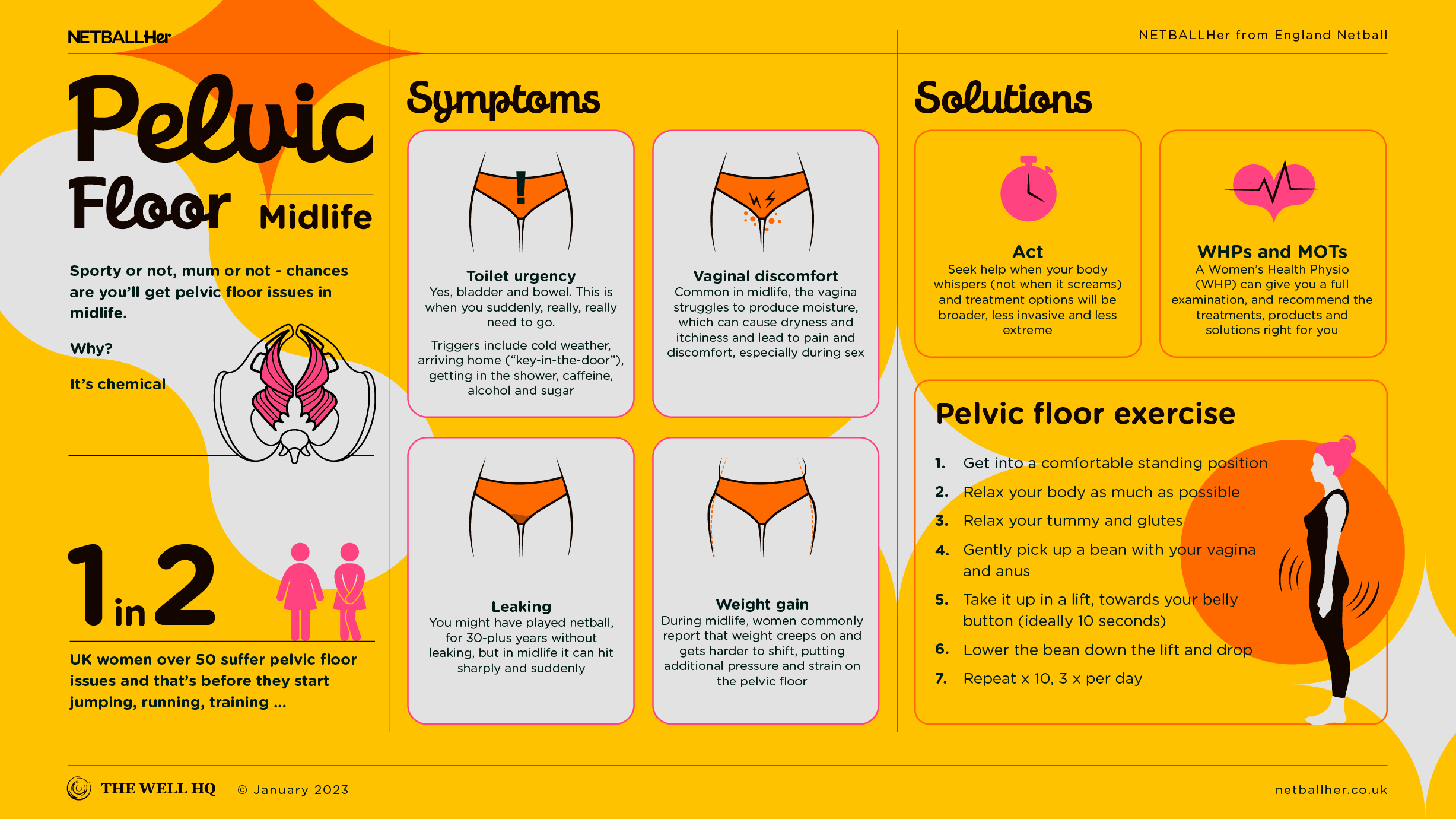Click play for an audio readthrough of this article
Get ahead of the inevitable
Sporty or not, mum or not – chances are you’ll get pelvic floor issues in midlife. Why? It’s chemical.
One in three UK women has a pelvic floor issue. The likelihood increases if you’re an athlete, if you have a baby … and it when you enter midlife.
Yes, that’s two ifs and a when. Because menopause is inevitable and the pelvic floor issues that appear during the phase we call midlife aren’t just based on wear-and-tear or impact, but our changing hormones.
What does that mean? It means the oestrogen levels flowing through the pelvic floor and vagina start to decline and taper off. In basic terms, the pelvic floor takes a massive hit during menopause – or technically perimenopause; the first of the three menopause phases.
Even if you’ve escaped pelvic floor issues so far in life, symptoms will probably catch up with you in midlife.
Symptoms, like what?
Toilet urgency
Yes, bladder and bowel. This is when you suddenly, really, really need to go.
Commonly, midlife women find that cold weather is a trigger for toilet urgency, as are stimulants such as caffeine, alcohol and sugar. It’s an unfortunate irony: the things many of us rely on for relief wind up causing even more problems and discomfort.
If you know women in midlife who’ve changed their relationships with alcohol and/or caffeine and/or sugar – this is why.
Leaking
You might have played netball, or another high-impact sport, for 30-plus years without leaking so much as a droplet. But leaking can hit sharply and suddenly, even if you’re only doing what you’ve always done.
This leaking may be a result of your weakening pelvic floor, or it could be due to vaginal atrophy which is when the muscles in the vagina, starved of oestrogen, start to wither.
Solutions here start with pelvic floor exercises, and may also include a microdose of topical HRT, available through your GP.
Vaginal dryness/ itchiness
This is quite unique to midlife. And it’s very common. With the vagina getting less of what it needs it struggles to produce moisture. This leads to dryness and itchiness which, in turn, leads to pain and discomfort in general – and especially during sex.
Here, topical oestrogen can be a massive help. It helps to bulk up vaginal tissue and boost the production of moisture to ease dryness and itchiness.
Vaginal oestrogen is also available in the form of pessaries, cream or a vaginal ring while vaginal lubricant and moisturisers can help you associate sex, once again, with pleasure – not pain.
Weight gain
During midlife, women commonly report that weight creeps on and gets harder to shift.
Being overweight, or obese, ramps up the potential for pelvic floor problems in women of any age as that area has to carry more weight. A 10% reduction in weight can lead to a 50% drop in the severity of symptoms.
Midlife weight gain often prompts women, especially those who like to keep fit and active, to hit exercise harder; focusing on the single body parts (think bums and tums) where they’ve gained a few pounds.
But by midlife you simply can’t see body parts in isolation. Exercise is crucial, but the response has to be holistic; it has to consider all components of health such as nutrition, sleep and mental health.
Solutions
Act when your body whispers (don’t wait ‘till it screams)
Some women escape pelvic floor dysfunction their whole life until, during midlife/ menopause, the whispers start.
It’s important to take action when the body is whispering. Early action (when you start leaking, feeling pain, noticing bladder urgency) and the treatment options are broader and less extreme.
If you wait until the body’s screaming out, your treatment options will narrow and your options are likely to be medical and invasive.
Get on your pelvic floor exercises
If you’ve read other content in this section, you’ll know that the blanket rule to maintain a healthy pelvic floor is to stick with your daily pelvic floor exercise.
If you’ve missed it, here’s a reminder how to do those exercises.
When you notice symptoms that suggest your pelvic floor is struggling, it’s important to stick with your exercises. If after a month your symptoms haven’t eased, book some time with a Women’s Health Physio (WHP) – a specialist in this department.
WHPs and MOTs
A WHP can check you over and make recommendations on treatments, products and solutions. And they can make sure you’re exercising your pelvic floor correctly.
If you don’t know where to look for a WHP, the NHS’s Squeezy App Directory is a fantastic place to start but, as we’ve noted in other articles, WHPs are in high-demand and you may have to go private.
We’d also recommend booking in for a health MOT. Whether with a WHP or GP, it’s more vital than ever to check your health baselines when entering the midlife phase.
Problems may be more inevitable … but no need for despair. Solutions are plentiful.
As a reminder, the content of the course belongs to The Well HQ. You have permission to access and use the content yourself or, if you are an organisation, for the number of users selected, but are not otherwise permitted to share such content with others, all in accordance with our Course Terms and Conditions.

